Improving Total Carbon Storage Estimation Using Multi-Source Remote Sensing
Abstract
1. Introduction
2. Materials and Methods
2.1. Study Area
2.2. Methodology
2.2.1. Data Collection and Preprocessing
2.2.2. Ground-Based Measurements
2.2.3. Model Development and Training
2.2.4. Analysis and Cross-Validation
2.2.5. Estimation of Aboveground Biomass and the Total Carbon Storage
3. Results
3.1. Comparison of Different Models to Estimate DBH
3.2. The Driving Factors of DBH in Different Climate Zones
3.3. Total Carbon Storage Estimation
4. Discussion
4.1. Estimation of DBH Distribution and Biomass in Yunnan Province
4.1.1. Comparison of Different Models for DBH Estimation
4.1.2. Driving Factors of DBH in Different Climate Zones
4.2. Utilizing DBH Distribution Data for Biomass Allocation and TCS
4.2.1. Importance of DBH in Biomass Estimation
4.2.2. Biomass Allocation and Total Carbon Storage Estimation
4.3. Implications for Future Research and Forest Management
5. Conclusions
Author Contributions
Funding
Data Availability Statement
Acknowledgments
Conflicts of Interest
References
- Pan, Y.; Birdsey, R.; Fang, J.; Houghton, R.; Kauppi, P.; Kurz, W.; Phillips, O.; Shvidenko, A.; Lewis, S.; Canadell, J.; et al. A Large and Persistent Carbon Sink in the World’s Forests. Science 2011, 333, 988–993. [Google Scholar] [CrossRef]
- Harris, N.; Gibbs, D.; Baccini, A.; Birdsey, R.; de Bruin, S.; Farina, M.; Fatoyinbo, L.; Hansen, M.; Herold, M.; Houghton, R.; et al. Global maps of twenty-first century forest carbon fluxes. Nat. Clim. Change 2021, 11, 1–7. [Google Scholar] [CrossRef]
- Available online: https://www.plantplus.cn/cn/standards/10 (accessed on 24 February 2025).
- Chave, J.; Réjou-Méchain, M.; Burquez, A.; Chidumayo, E.; Colgan, M.; Delitti, W.; Duque, A.; Eid, T.; Fearnside, P.; Goodman, R.; et al. Improved allometric models to estimate the aboveground biomass of tropical trees. Glob. Change Biol. 2014, 20, 3177–3190. [Google Scholar] [CrossRef]
- Strîmbu, V.; Ene, L.; Gobakken, T.; Gregoire, T.; Astrup, R.; Næsset, E. Post-stratified change estimation for large-area forest biomass using repeated ALS strip sampling. Can. J. For. Res. 2017, 47, 839–847. [Google Scholar] [CrossRef]
- Crockett, E.; Atkins, J.; Guo, Q.; Sun, G.; Potter, K.; Ollinger, S.; Silva, C.; Tang, H.; Woodall, C.; Holgerson, J.; et al. Structural and species diversity explain aboveground carbon storage in forests across the United States: Evidence from GEDI and forest inventory data. Remote Sens. Environ. 2023, 295, 113703. [Google Scholar] [CrossRef]
- Deng, Y.; Wang, J.; Liu, Q.; Feng, B.; Zhang, J. The F-LS Algorithm for Extracting Tree Breast-Height Diameter. Remote Sens. Inf. 2022, 37, 77–84. [Google Scholar]
- Pubudunzhu, B.; Guo, Q.; Zhu, X.; Zhu, L. Modeling Allometric Growth Equations for Tree Height and Breast-Height Diameter of Picea likiangensis in Linzhi, Tibetan Plateau. Cent. South For. Inventory Plan. 2014, 33, 13–15+66. [Google Scholar]
- Zhang, Z.; Wang, T.; Skidmore, A.K.; Cao, F.; She, G.; Cao, L. An improved area-based approach for estimating plot-level tree DBH from airborne LiDAR data. For. Ecosyst. 2023, 10, 100089. [Google Scholar] [CrossRef]
- Bi, H.; Fox, J.C.; Li, Y.; Lei, Y.; Pang, Y. Evaluation of nonlinear equations for predicting diameter from tree height. Can. J. For. Res. 2012, 42, 789–806. [Google Scholar] [CrossRef]
- Veras, H.; Neto, E.; Brasil, I.; Madi, J.P.; Araujo, E.; Camaño, J.; Figueiredo, E.; Papa, D.; Ferreira, M.; Corte, A.; et al. Estimating tree volume based on crown mapping by UAV pictures in the Amazon Forest. Sci. Electron. Arch. 2023, 16, 7. [Google Scholar] [CrossRef]
- Teobaldelli, M.; Cona, F.; Saulino, L.; Migliozzi, A.; D’Urso, G.; Langella, G.; Manna, P.; Saracino, A. Detection of Diversity and Stand Parameters in Mediterranean Forests Using Leaf-off Discrete Return LiDAR Data. Remote Sens. Environ. 2017, 192, 126–138. [Google Scholar] [CrossRef]
- Silva, C.; Klauberg, C.; Hudak, A.T.; Vierling, L.; Fennema, S.; Corte, A. Modeling and mapping basal area of Pinus taeda L. plantation using airborne LiDAR data. An. Acad. Bras. Ciências 2017, 89, 1895–1905. [Google Scholar] [CrossRef] [PubMed]
- Sun, Y.; Jin, X.; Pukkala, T.; Li, F. Predicting Individual Tree Diameter of Larch (Larix olgensis) from UAV-LiDAR Data Using Six Different Algorithms. Remote Sens. 2022, 14, 1125. [Google Scholar] [CrossRef]
- Fei, L.; Yue, C.; Jin, J.; Li, C.; Luo, H.; Wanting, X. Study on the inversion of basal area from airborne liDAR data. For. Resour. Manag. 2021, 15, 62–69. [Google Scholar]
- Dash, J.; Marshall, H.; Rawley, B. Methods for estimating multivariate stand yields and errors using k-NN and aerial laser scanning. Forestry 2015, 88, 237–247. [Google Scholar] [CrossRef]
- Lefsky, M.; Cohen, W.B.; Acker, S.; Parker, G.; Spies, T.A.; Harding, D. Lidar Remote Sensing of the Canopy Structure and Biophysical Properties of Douglas-Fir Western Hemlock Forests. Remote Sens. Environ. 1999, 70, 339–361. [Google Scholar] [CrossRef]
- Liu, H.; Zhang, Z.; Cao, L. Estimating forest stand characteristics in a coastal plain forest plantation based on vertical structure profile parameters derived from ALS data. J. Remote Sens. 2018, 22, 872–888. [Google Scholar] [CrossRef]
- Jucker, T.; Caspersen, J.; Chave, J.; Antin, C.; Barbier, N.; Bongers, F.; Dalponte, M.; van Ewijk, K.Y.; Forrester, D.I.; Haeni, M.; et al. Allometric equations for integrating remote sensing imagery into forest monitoring programmes. Glob. Change Biol. 2017, 23, 177–190. [Google Scholar] [CrossRef]
- Gonzalez de Tanago, J.; Sarmiento, A.L.; Bartholomeus, H.; Herold, M.; Avitabile, V.; Raumonen, P.; Martius, C.; Goodman, R.; Disney, M.; Manuri, S.; et al. Estimation of above-ground biomass of large tropical trees with Terrestrial LiDAR. Methods Ecol. Evol. 2017, 9, 223–234. [Google Scholar] [CrossRef]
- Panagiotidis, D.; Abdollahnejad, A.; Surovy, P.; Chiteculo, V. Determining tree height and crown diameter from high-resolution UAV imagery. Int. J. Remote Sens. 2017, 38. [Google Scholar] [CrossRef]
- Abdollahnejad, A.; Panagiotidis, D.; Surový, P. Forest canopy density assessment using different approaches-review. J. For. Sci. 2017, 63, 107–116. [Google Scholar] [CrossRef]
- Abdollahnejad, A.; Panagiotidis, D.; Surový, P. Estimation and Extrapolation of Tree Parameters Using Spectral Correlation between UAV and Pléiades Data. Forests 2018, 9, 85. [Google Scholar] [CrossRef]
- Fassnacht, F.; Latifi, H.; Stereńczak, K.; Modzelewska, A.; Lefsky, M.; Waser, L.; Straub, C.; Ghosh, A. Review of studies on tree species classification from remotely sensed data. Remote Sens. Environ. 2016, 186, 64–87. [Google Scholar] [CrossRef]
- Immitzer, M.; Atzberger, C.; Koukal, T. Tree Species Classification with Random Forest Using Very High Spatial Resolution 8-Band WorldView-2 Satellite Data. Remote Sens. 2012, 4, 2661–2693. [Google Scholar] [CrossRef]
- Kc, Y.; Liu, Q.; Saud, P.; Gaire, D.; Adhikari, H. Estimation of Above-Ground Forest Biomass in Nepal by the Use of Airborne LiDAR, and Forest Inventory Data. Land 2024, 13, 213. [Google Scholar] [CrossRef]
- Dubayah, R.; Blair, J.; Goetz, S.; Fatoyinbo, L.; Hansen, M.; Healey, S.; Hofton, M.; Hurtt, G.; Kellner, J.; Luthcke, S.; et al. The Global Ecosystem Dynamics Investigation: High-resolution laser ranging of the Earth’s forests and topography. Sci. Remote Sens. 2020, 1, 100002. [Google Scholar] [CrossRef]
- Hansen, M.C.; Potapov, P.; Moore, R.; Hancher, M.; Turubanova, S.; Tyukavina, A.; Thau, D.; Stehman, S.; Goetz, S.; Loveland, T.; et al. High-Resolution Global Maps of 21st-Century Forest Cover Change. Science 2013, 342, 850–853. [Google Scholar] [CrossRef]
- Ferraz, A.; Saatchi, S.; Mallet, C.; Meyer, V. Lidar detection of individual tree size in tropical forests. Remote Sens. Environ. 2016, 183, 318–333. [Google Scholar] [CrossRef]
- Motohka, T.; Nasahara, K.; Oguma, H.; Tsuchida, S. Applicability of Green-Red Vegetation Index for Remote Sensing of Vegetation Phenology. Remote Sens. 2010, 2, 2369–2387. [Google Scholar] [CrossRef]
- Abdollahnejad, A.; Panagiotidis, D. Tree Species Classification and Health Status Assessment for a Mixed Broadleaf-Conifer Forest with UAS Multispectral Imaging. Remote Sens. 2020, 12, 3722. [Google Scholar] [CrossRef]
- Mascaro, J.; Asner, G.; Muller-Landau, H.; van Breugel, M.; Hall, J.; Dahlin, K. Controls over aboveground forest carbon density on Barro Colorado Island, Panama. Biogeosciences Discuss. 2010, 8, 1615–1629. [Google Scholar] [CrossRef]
- Clark, M.; Roberts, D.; Clark, D. Hyperspectral discrimination of tropical rain forest tree species at leaf to crown scales. Remote Sens. Environ. 2005, 96, 375–398. [Google Scholar] [CrossRef]
- Breiman, L. Random Forests. Mach. Learn. 2001, 45, 5–32. [Google Scholar] [CrossRef]
- Xie, B.; Jones, P.; Dwivedi, R.; Bao, L.; Liang, R. Evaluation, comparison, and unique features of ecological security in southwest China: A case study of Yunnan Province. Ecol. Indic. 2023, 153, 110453. [Google Scholar] [CrossRef]
- Yang, R.; He, Y.; Zhong, C.; Yang, Z.; Wang, X.; Xu, M.; Cao, L. Study on the Spatiotemporal Evolution and Influencing Factors of Forest Coverage Rate (FCR): A Case Study on Yunnan Province Based on Remote Sensing Image Interpretation. Forests 2024, 15, 238. [Google Scholar] [CrossRef]
- Forestry Department of Yunnan Province. Forest Site Classification and Its Application in Yunnan; China Forestry Publishing House: Beijing, China, 1990.
- Gong, Z.; Ge, W.; Guo, J.; Liu, J. Satellite remote sensing of vegetation phenology: Progress, challenges, and opportunities. ISPRS J. Photogramm. Remote. Sens. 2024, 217, 149–164. [Google Scholar] [CrossRef]
- Cheng, K.; Chen, Y.; Xiang, T.; Yang, H.; Liu, W.; Ren, Y.; Guan, H.; Hu, T.; Ma, Q.; Guo, Q. A 2020 forest age map for China with 30 m resolution. Earth Syst. Sci. Data 2024, 16, 803–819. [Google Scholar] [CrossRef]
- Hengl, T.; de Jesus, J.M.; Heuvelink, G.; Gonzalez, M.; Kilibarda, M.; Blagotić, A.; Shangguan, W.; Wright, M.; Geng, X.; Bauer-Marschallinger, B.; et al. SoilGrids250m: Global gridded soil information based on machine learning. PLoS ONE 2017, 12, e0169748. [Google Scholar] [CrossRef] [PubMed]
- Margolis, H.A.; Nelson, R.F.; Montesano, P.M.; Beaudoin, A.; Sun, G.; Andersen, H.-E.; Wulder, M.A. Combining satellite lidar, airborne lidar, and ground plots to estimate the amount and distribution of aboveground biomass in the boreal forest of North America. Can. J. For. Res. 2015, 45, 838–855. [Google Scholar] [CrossRef]
- Cortes, C.J.M.L. Support-Vector Networks; AT&T Bell Labs.: Holmdel, NJ, USA, 1995. [Google Scholar]
- Friedman, J.H. Greedy Function Approximation: A Gradient Boosting Machine. Ann. Stat. 2001, 1189–1232. Available online: https://www.jstor.org/stable/2699986 (accessed on 24 February 2025). [CrossRef]
- McCulloch, W.S.; Pitts, W. A logical calculus of the ideas immanent in nervous activity. Bull. Math. Biophys. 1943, 5, 115–133. [Google Scholar] [CrossRef]
- Quinlan, J.R. Induction of decision trees. Mach. Learn. 1986, 1, 81–106. [Google Scholar] [CrossRef]
- Rumelhart, D.E.; Hinton, G.E.; Williams, R.J. Learning representations by back-propagating errors. Nature 1986, 323, 533–536. [Google Scholar] [CrossRef]
- Murphy, K.P. Machine Learning: A Probabilistic Perspective (Adaptive Computation and Machine Learning Series); The MIT Press: London, UK, 2012. [Google Scholar]
- Roy, A.D.; Yule, G.U.; Kendall, M.G. An Introduction to the Theory of Statistics. Econ. J. 1968, 60, 788. [Google Scholar] [CrossRef]
- Fang, J.; Chen, A.; Peng, C.; Zhao, S.; Ci, L. Changes in Forest Biomass Carbon Storage in China Between 1949 and 1998. Science 2001, 292, 2320–2322. [Google Scholar] [CrossRef] [PubMed]
- Wulder, M.A.; White, J.C.; Goward, S.N.; Masek, J.G.; Irons, J.R.; Herold, M.; Cohen, W.B.; Loveland, T.R.; Woodcock, C.E. Landsat continuity: Issues and opportunities for land cover monitoring. Remote Sens. Environ. 2008, 112, 955–969. [Google Scholar] [CrossRef]
- Avitabile, V.; Herold, M.; Heuvelink, G.B.M.; Lewis, S.L.; Phillips, O.L.; Asner, G.P.; Armston, J.; Ashton, P.S.; Banin, L.; Bayol, N.; et al. An integrated pan-tropical biomass map using multiple reference datasets. Glob. Change Biol. 2016, 22, 1406–1420. [Google Scholar] [CrossRef] [PubMed]
- Wang, F.; Heenkenda, M.K.; Freeburn, J.T. Estimating tree Diameter at Breast Height (DBH) using an iPad Pro LiDAR sensor. Remote Sens. Lett. 2022, 13, 568–578. [Google Scholar] [CrossRef]
- Ghanbari Parmehr, E.; Amati, M. Individual Tree Canopy Parameters Estimation Using UAV-Based Photogrammetric and LiDAR Point Clouds in an Urban Park. Remote Sens. 2021, 13, 2062. [Google Scholar] [CrossRef]
- Corte, A.P.D.; Souza, D.V.; Rex, F.E.; Sanquetta, C.R.; Mohan, M.; Silva, C.A.; Zambrano, A.M.A.; Prata, G.; de Almeida, D.R.A.; Trautenmüller, J.W.; et al. Forest inventory with high-density UAV-Lidar: Machine learning approaches for predicting individual tree attributes. Comput. Electron. Agric. 2020, 179, 105815. [Google Scholar] [CrossRef]
- Neuville, R.; Bates, J.S.; Jonard, F. Estimating Forest Structure from UAV-Mounted LiDAR Point Cloud Using Machine Learning. Remote Sens. 2021, 13, 352. [Google Scholar] [CrossRef]
- Balling, J.; Slagter, B.; Woude, S.; Herold, M.; Reiche, J. ALOS-2 PALSAR-2 ScanSAR and Sentinel-1 data for timely tropical forest disturbance mapping: A case study for Sumatra, Indonesia. Int. J. Appl. Earth Obs. Geoinf. 2024, 132, 103994. [Google Scholar] [CrossRef]
- Reiche, J.; Lucas, R.; Mitchell, A.L.; Verbesselt, J.; Hoekman, D.H.; Haarpaintner, J.; Kellndorfer, J.M.; Rosenqvist, A.; Lehmann, E.A.; Woodcock, C.E.; et al. Combining satellite data for better tropical forest monitoring. Nat. Clim. Change 2016, 6, 120–122. [Google Scholar] [CrossRef]
- Verrelst, J.; Camps-Valls, G.; Muñoz-Marí, J.; Rivera, J.P.; Veroustraete, F.; Clevers, J.G.P.W.; Moreno, J. Optical remote sensing and the retrieval of terrestrial vegetation bio-geophysical properties—A review. ISPRS J. Photogramm. Remote Sens. 2015, 108, 273–290. [Google Scholar] [CrossRef]
- Belgiu, M.; Drăguţ, L. Random forest in remote sensing: A review of applications and future directions. ISPRS J. Photogramm. Remote Sens. 2016, 114, 24–31. [Google Scholar] [CrossRef]
- Wang, Y.; Liu, Y.; Chen, P.; Song, J.; Fu, B. Interannual precipitation variability dominates the growth of alpine grassland above-ground biomass at high elevations on the Tibetan Plateau. Sci. Total Environ. 2024, 931, 172745. [Google Scholar] [CrossRef]
- Mehmood, K.; Anees, S.A.; Rehman, A.; Rehman, N.U.; Muhammad, S.; Shahzad, F.; Liu, Q.; Alharbi, S.A.; Alfarraj, S.; Ansari, M.J.; et al. Assessment of climatic influences on net primary productivity along elevation gradients in temperate ecoregions. Trees For. People 2024, 18, 100657. [Google Scholar] [CrossRef]
- Zhang, X.; Wang, Y.; Wang, J.; Yu, M.; Zhang, R.; Mi, Y.; Xu, J.; Jiang, R.; Gao, J. Elevation Influences Belowground Biomass Proportion in Forests by Affecting Climatic Factors, Soil Nutrients and Key Leaf Traits. Plants 2024, 13, 674. [Google Scholar] [CrossRef] [PubMed]
- Cao, W.; Liu, T.; Wang, X. Effects of soil properties on vegetation community composition across a semiarid ecosystem. J. Arid. Environ. 2022, 198, 104700. [Google Scholar] [CrossRef]
- Li, C.; Li, M.; Iizuka, K.; Liu, J.; Chen, K.; Li, Y. Effects of Forest Canopy Structure on Forest Aboveground Biomass Estimation Using Landsat Imagery. IEEE Access 2021, 9, 5285–5295. [Google Scholar] [CrossRef]
- Ma, L.; Lian, J.; Lin, G.; Cao, H.; Huang, Z.; Guan, D. Forest dynamics and its driving forces of sub-tropical forest in South China. Sci. Rep. 2016, 6, 22561. [Google Scholar] [CrossRef] [PubMed]
- Cusack, D.F.; Karpman, J.; Ashdown, D.; Cao, Q.; Ciochina, M.; Halterman, S.; Lydon, S.; Neupane, A. Global change effects on humid tropical forests: Evidence for biogeochemical and biodiversity shifts at an ecosystem scale. Rev. Geophys. 2016, 54, 523–610. [Google Scholar] [CrossRef]
- Li, S.; Zhang, A.; Song, H.; Guo, W.; Tang, Z.; Lei, G.; Qi, L. The Dominant Factor Affecting Soil Organic Carbon in Subtropical Phyllostachys edulis Forests Is Climatic Factors Rather Than Soil Physicochemical Properties. Forests 2023, 14, 958. [Google Scholar] [CrossRef]
- Schippers, P.; Sterck, F.; Vlam, M.; Zuidema, P.A. Tree growth variation in the tropical forest: Understanding effects of temperature, rainfall and CO2. Glob. Change Biol. 2015, 21, 2749–2761. [Google Scholar] [CrossRef] [PubMed]
- Linger, E.; Hogan, J.A.; Cao, M.; Zhang, W.-F.; Yang, X.-F.; Hu, Y.-H. Precipitation influences on the net primary productivity of a tropical seasonal rainforest in Southwest China: A 9-year case study. For. Ecol. Manag. 2020, 467, 118153. [Google Scholar] [CrossRef]
- Soong, J.L.; Janssens, I.A.; Grau, O.; Margalef, O.; Stahl, C.; Van Langenhove, L.; Urbina, I.; Chave, J.; Dourdain, A.; Ferry, B.; et al. Soil properties explain tree growth and mortality, but not biomass, across phosphorus-depleted tropical forests. Sci. Rep. 2020, 10, 2302. [Google Scholar] [CrossRef] [PubMed]
- Deb, J.C.; Phinn, S.; Butt, N.; McAlpine, C. Climate change impacts on tropical forests: Identifying risks for tropical Asia. J. Trop. For. Sci. 2018, 30, 182–194. [Google Scholar]
- Lin, S.; Li, Y.; Li, Y.; Chen, Q.; Wang, Q.; He, K. Influence of tree size, local forest structure, topography, and soil resource availability on plantation growth in Qinghai Province, China. Ecol. Indic. 2021, 120, 106957. [Google Scholar] [CrossRef]
- Nabeshima, E.; Kubo, T.; Hiura, T. Variation in tree diameter growth in response to the weather conditions and tree size in deciduous broad-leaved trees. For. Ecol. Manag. 2010, 259, 1055–1066. [Google Scholar] [CrossRef]
- Zolkos, S.; Goetz, S.; Dubayah, R. Dubayah, A meta-analysis of terrestrial aboveground biomass estimation using lidar remote sensing. Remote Sens. Environ. 2013, 128, 289–298. [Google Scholar] [CrossRef]
- Dai, Z.; Birdsey, R.A.; Johnson, K.D.; Dupuy, J.M.; Hernandez-Stefanoni, J.L.; Richardson, K. Modeling carbon stocks in a secondary tropical dry forest in the Yucatan Peninsula, Mexico. Water Air Soil Pollut. 2014, 225, 1–15. [Google Scholar] [CrossRef]
- Li, L. Dynamic Change of Carbon Storage and Carbon Sink Potential of Forest Vegetation in Yunnan Province from 1992 to 2007; Yunnan University of Finance and Economics: Kunming, China, 2012. [Google Scholar]
- Vashum, K.T.; Jayakumar, S. Methods to estimate above-ground biomass and carbon stock in natural forests—A review. J. Ecosyst. Ecography 2012, 2, 1–7. [Google Scholar] [CrossRef]
- Sleeter, B.M.; Liu, J.; Daniel, C.; Rayfield, B.; Sherba, J.; Hawbaker, T.J.; Zhu, Z.; Selmants, P.C.; Loveland, T.R. Effects of contemporary land-use and land-cover change on the carbon balance of terrestrial ecosystems in the United States. Environ. Res. Lett. 2018, 13, 045006. [Google Scholar] [CrossRef]
- Schimel, D. Forests in the Global Carbon Cycle. In Challenges and Opportunities for the World’s Forests in the 21st Century; Springer: Berlin/Heidelberg, Germany, 2013; pp. 231–239. [Google Scholar]
- Yao, L.; Liu, T.; Qin, J.; Jiang, H.; Yang, L.; Smith, P.; Chen, X.; Zhou, C.; Piao, S. Carbon sequestration potential of tree planting in China. Nat. Commun. 2024, 15, 8398. [Google Scholar] [CrossRef] [PubMed]
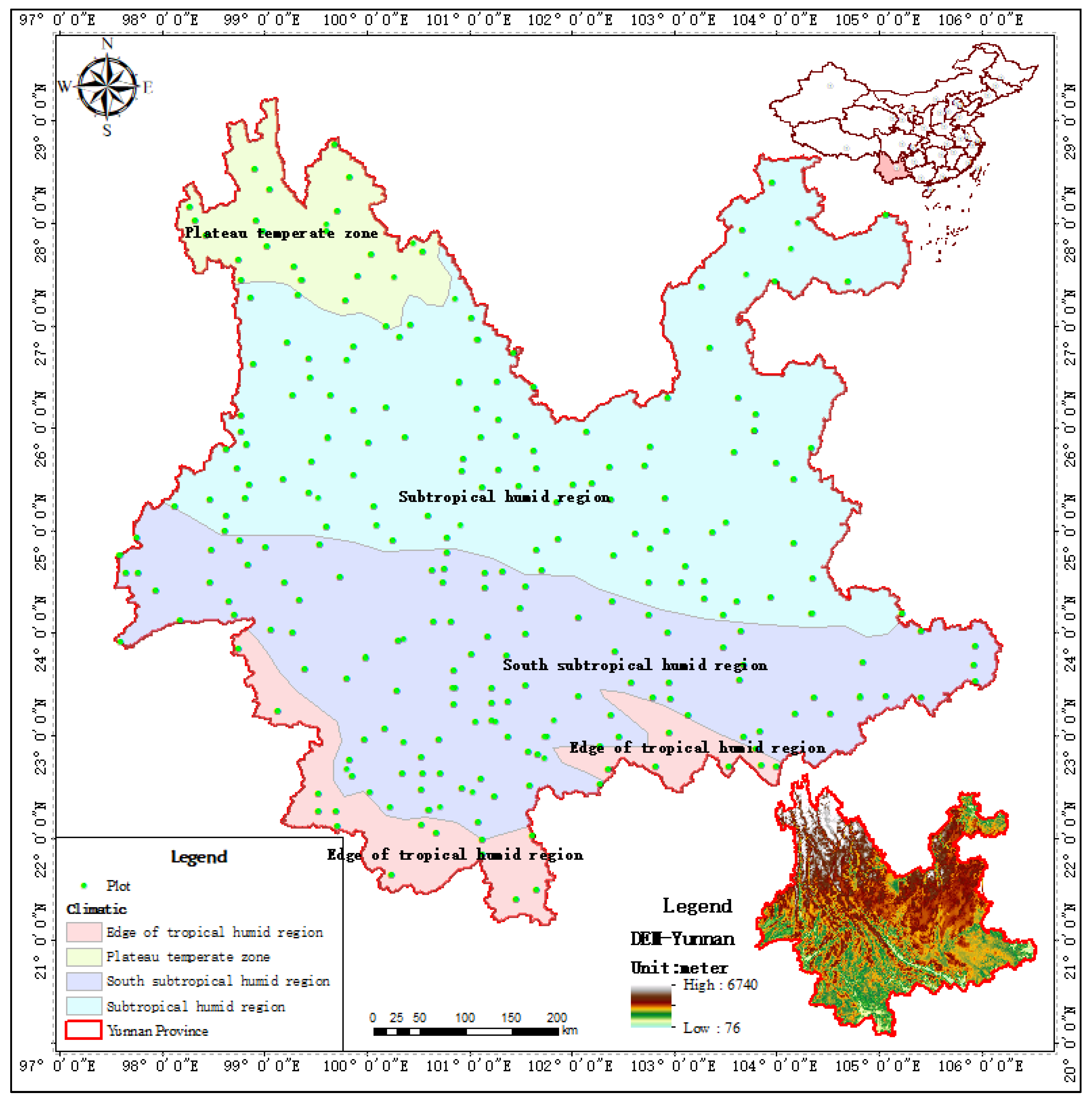



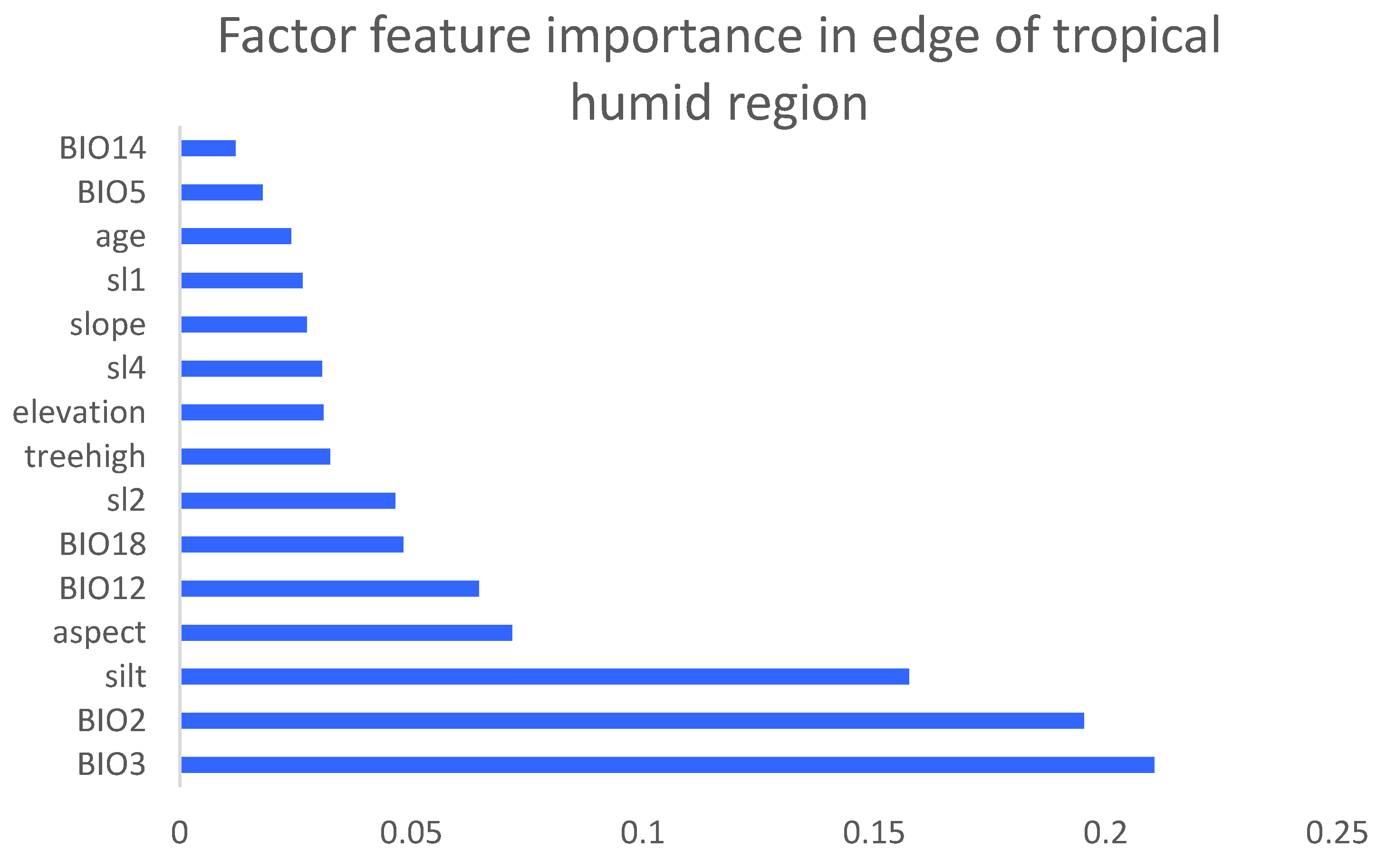
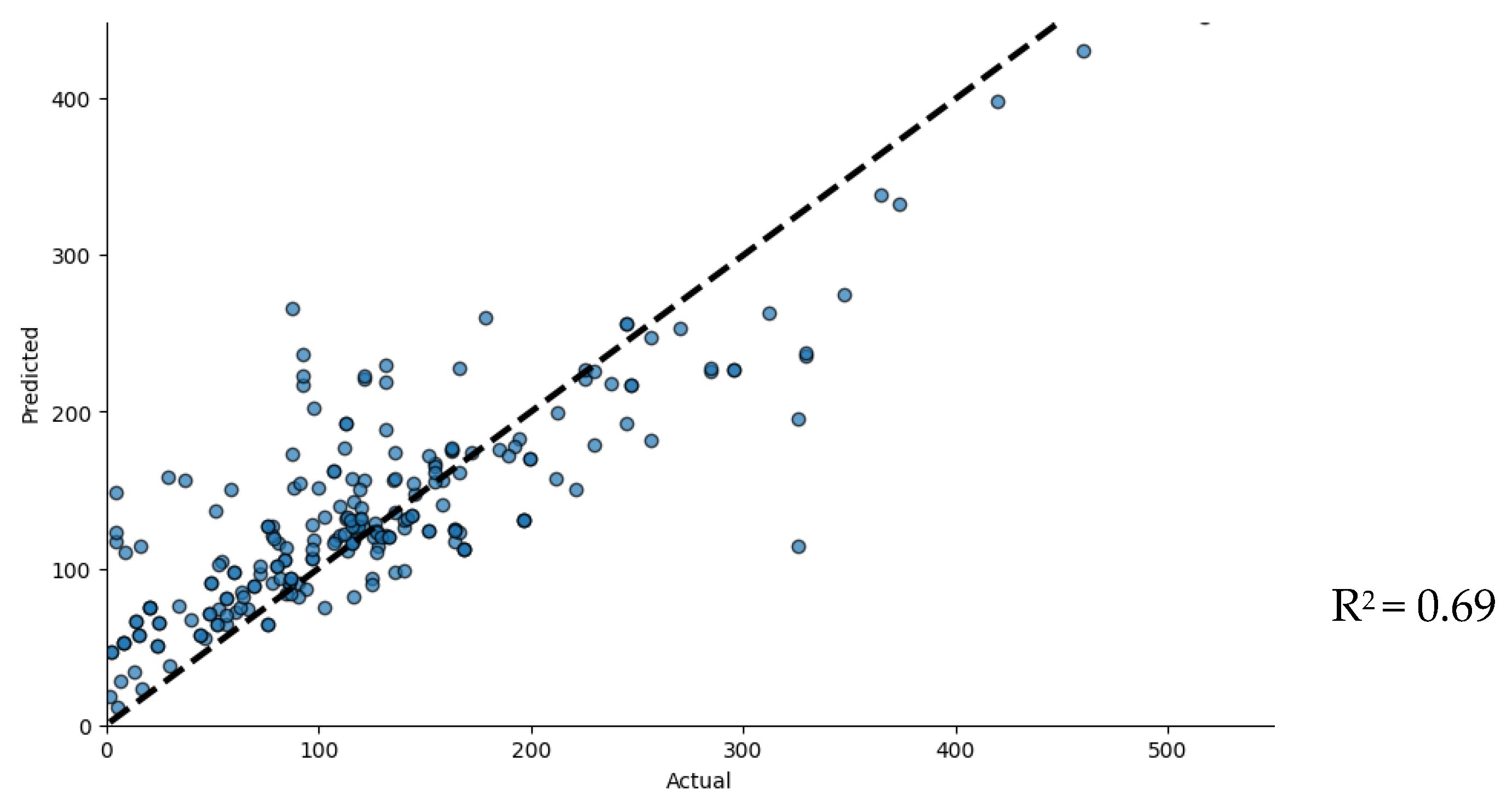



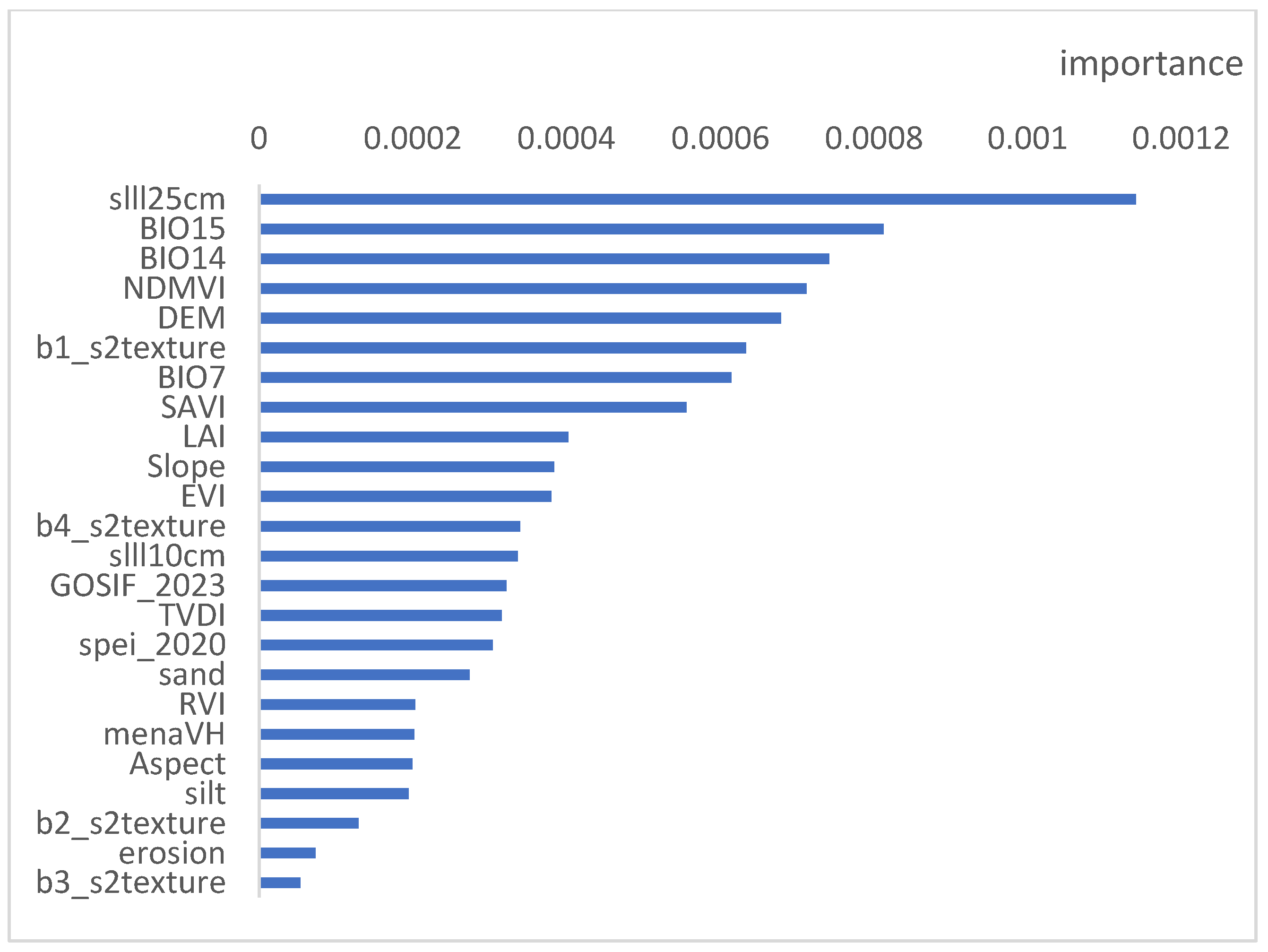
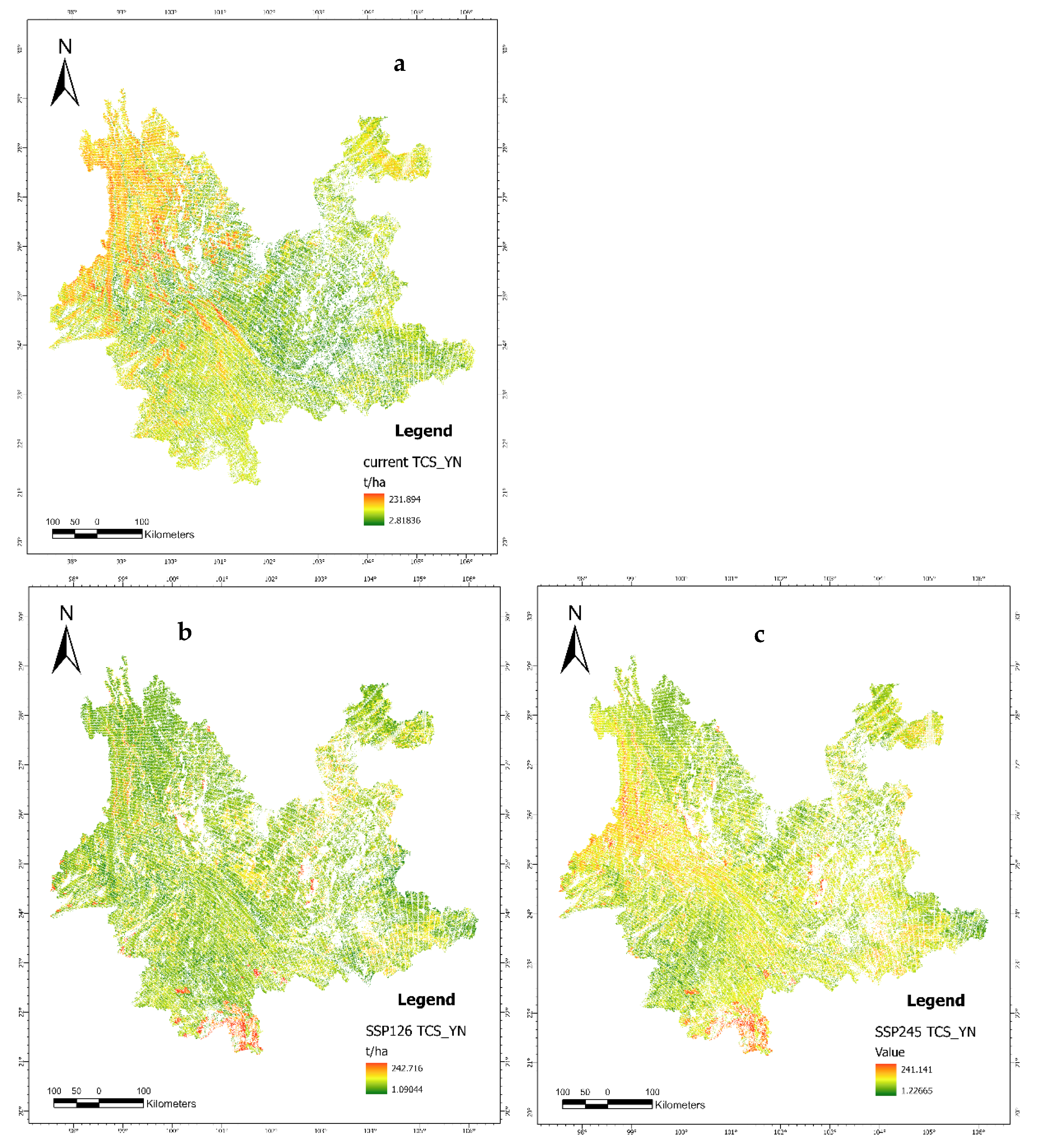
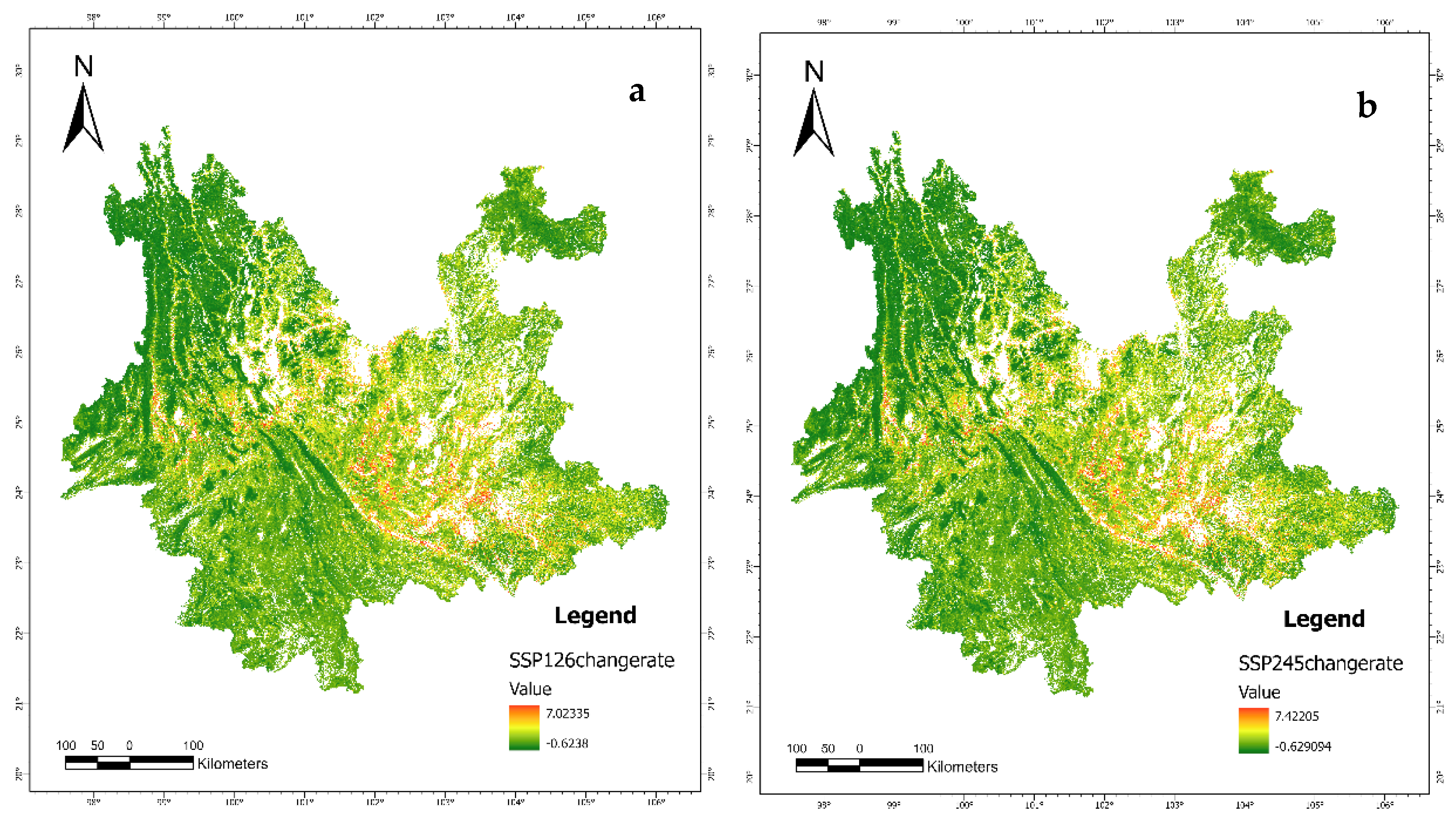
| Factors | Remark | Data Source | |
|---|---|---|---|
| Environmental factor | BIO1: | Annual Mean Temperature (°C) | www.worldclim.org accessed from 1970–2000 |
| BIO2: | Mean Diurnal Range (Mean of monthly (max temp–min temp)) (°C) | ||
| BIO3: | Isothermality (BIO2/BIO7) (×100) | ||
| BIO4: | Temperature Seasonality (standard deviation ×100) | ||
| BIO5: | Max Temperature of Warmest Month (°C) | ||
| BIO6: | Min Temperature of Coldest Month (°C) | ||
| BIO7: | Temperature Annual Range (BIO5-BIO6) (°C) | ||
| BIO8: | Mean Temperature of Wettest Quarter (°C) | ||
| BIO9: | Mean Temperature of Driest Quarter (°C) | ||
| BIO10: | Mean Temperature of Warmest Quarter (°C) | ||
| BIO11: | Mean Temperature of Coldest Quarter (°C) | ||
| BIO12: | Annual Precipitation (mm) | ||
| BIO13: | Precipitation of Wettest Month (mm) | ||
| BIO14: | Precipitation of Driest Month (mm) | ||
| BIO15: | Precipitation Seasonality (Coefficient of Variation) (mm) | ||
| BIO16: | Precipitation of Wettest Quarter (mm) | ||
| BIO17: | Precipitation of Driest Quarter (mm) | ||
| BIO18: | Precipitation of Warmest Quarter (mm) | ||
| BIO19: | Precipitation of Coldest Quarter (mm) | ||
| Topographic feature | Elevation | This refers to the height above sea level | https://earthexplorer.usgs.gov/ accessed in 2000 |
| Slope | The slope refers to the steepness of the terrain | Derive from the DEM in use of arcgis | |
| Aspect | Aspect refers to the direction a slope faces | Derive from the DEM in use of arcgis | |
| Spectral data | kNDVI | Kernel Normalized Difference Vegetation Index: This is a vegetation index used to assess the health and density of vegetation | Derive from Landsat 8 and Sentinel-2 in use of GEE |
| GOSIF | Global Solar-Induced Chlorophyll Fluorescence is a global dataset that provides information on solar-induced chlorophyll fluorescence (SIF), which is an energy flux re-emitted by plants a few nanoseconds after light absorption | https://doi.org/10.3390/rs11050517 accessed in 2020 | |
| Soil property | silt | Silt is a type of soil particle that is finer than sand but coarser than clay | The Second National Soil Survey |
| sand | Sand is a granular material composed of finely divided rock and mineral particles | ||
| clay | Clay is a fine-grained soil that is plastic when wet and hard when dry | ||
| sl1-sl7 | SoilGrids250m Global gridded soil information base, sl1 represents a soil depth of 0 cm, sl2 represents a soil depth of 5 cm, sl3 represents a soil depth of 15 cm, sl4 represents a soil depth of 30 cm, sl5 represents a soil depth of 60 cm, sl6 represents a soil depth of 100 cm, and sl7 represents a soil depth of 250 cm | https://www.resdc.cn/Default.aspx accessed on June 2020 | |
| Vegetation characteristics | Tree height | This is a measure of the vertical growth of trees | Derive from Sentinel_1 |
| Tree age | A 2020 forest age map of China with 30 m resolution | [39] | |
| Ground measurements | DBH | Diameter at breast height | Investigation |
| Species | Identify plant species | https://www.iplant.cn/ | |
| Multi-source remote sensing | Sentinel_1 | Derive the tree height and the VV (vertical transmit/vertical receive) and VH (vertical transmit/horizontal receive) polarized bands | Sentinel-1|NASA Earthdata |
| Sentinel_2 | Derive the Kndvi, b1texture, b2texture, b3texture, and b4texture | Sentinel-2|NASA Earthdata | |
| Land use data | Derive the distribution of forest ecosystem | https://data.tpdc.ac.cn/en/data accessed on July 2020 | |
| Landsat 8 | Derive the kNDVI | www.resdc.cn/data.aspx accessed on June 2020 | |
| UAV Lidar data | UAV near ground remote sensing | Investigation |
| Models | MSE | RMSE | R2 |
|---|---|---|---|
| Random Forest | 437.187 | 20.909 | 0.895 |
| Gradient Boosting | 967.202 | 31.100 | 0.769 |
| Neural Network | 2340.843 | 48.382 | 0.440 |
| Decision Tree | 46.565 | 6.824 | 0.989 |
| Support Vector Machine | 3822.291 | 61.825 | 0.086 |
| Climatic Region | Models | MSE | RMSE | R2 |
|---|---|---|---|---|
| Plateau temperature zone | Random Forest | 916.701 | 30.277 | 0.820 |
| Gradient Boosting | 1201.673 | 34.665 | 0.765 | |
| Neural Network | 3135.475 | 55.995 | 0.386 | |
| Decision Tree | 1287.545 | 35.882 | 0.748 | |
| Support Vector Machine | 4458.343 | 66.771 | 0.127 | |
| South subtropical humid region | Random Forest | 421.345 | 20.527 | 0.804 |
| Gradient Boosting | 270.394 | 16.444 | 0.874 | |
| Neural Network | 1588.498 | 39.856 | 0.260 | |
| Decision Tree | 924.092 | 30.399 | 0.570 | |
| Support Vector Machine | 2064.101 | 45.432 | 0.039 | |
| Edge of tropical humid region | Random Forest | 148.233 | 12.175 | 0.956 |
| Gradient Boosting | 55.952 | 7.480 | 0.983 | |
| Neural Network | 1260.239 | 35.500 | 0.625 | |
| Decision Tree | 126.170 | 11.233 | 0.962 | |
| Support Vector Machine | 3240.899 | 56.929 | 0.035 |
Disclaimer/Publisher’s Note: The statements, opinions and data contained in all publications are solely those of the individual author(s) and contributor(s) and not of MDPI and/or the editor(s). MDPI and/or the editor(s) disclaim responsibility for any injury to people or property resulting from any ideas, methods, instructions or products referred to in the content. |
© 2025 by the authors. Licensee MDPI, Basel, Switzerland. This article is an open access article distributed under the terms and conditions of the Creative Commons Attribution (CC BY) license (https://creativecommons.org/licenses/by/4.0/).
Share and Cite
Zhou, H.; Liu, W.; De Boeck, H.J.; Ma, Y.; Zhang, Z. Improving Total Carbon Storage Estimation Using Multi-Source Remote Sensing. Forests 2025, 16, 453. https://doi.org/10.3390/f16030453
Zhou H, Liu W, De Boeck HJ, Ma Y, Zhang Z. Improving Total Carbon Storage Estimation Using Multi-Source Remote Sensing. Forests. 2025; 16(3):453. https://doi.org/10.3390/f16030453
Chicago/Turabian StyleZhou, Huoyan, Wenjun Liu, Hans J. De Boeck, Yufeng Ma, and Zhiming Zhang. 2025. "Improving Total Carbon Storage Estimation Using Multi-Source Remote Sensing" Forests 16, no. 3: 453. https://doi.org/10.3390/f16030453
APA StyleZhou, H., Liu, W., De Boeck, H. J., Ma, Y., & Zhang, Z. (2025). Improving Total Carbon Storage Estimation Using Multi-Source Remote Sensing. Forests, 16(3), 453. https://doi.org/10.3390/f16030453






